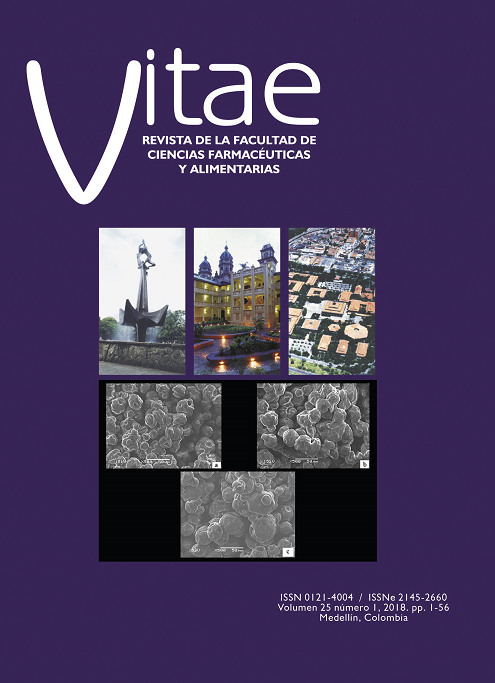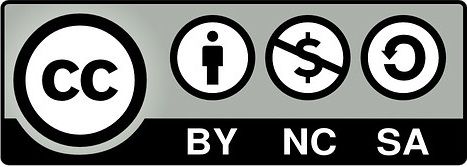Kinetic modeling of the enzymatic hydrolysis of proteins of visceras from red tilapia (Oreochromis sp.): effect of substrate and enzyme concentration
DOI:
https://doi.org/10.17533/udea.vitae.v25n1a03Keywords:
degree of hydrolysis, substrate inhibition, reaction rate, kinetic parameters, math models.Abstract
Background: the growth of world aquaculture has generated important environmental impacts as discard residues that are important sources of protein, which has been used to manufacture low-value products, such as animal food, fish flour and fertilizers. Objectives: to evaluate the effect of enzyme and substrate concentration on the degree of hydrolysis (DH) of proteins in the red tilapia (Oreochromis sp.) viscera (RTV). Methods: the commercial alcalase 2.4 L enzyme was used at different concentrations to hydrolyse the proteins in RTV at 53.5°C and a pH of 9.5 in a 1 L magnetically stirred, jacketed, glass batch reactor connected to an automatic titrator. Each experiment was conducted over 6 h in which every consumed volume of base was recorded every 5 min to determine the corresponding DH at each point. Results: the results indicated that increasing the enzyme concentration produced an increase in the DH and in the reaction rate, while increasing the substrate concentration produced a decrease in both parameters. For this reason, a mathematical model was adjusted for the inhibition of substrate from the exponential kinetic equation d(DH)/dt = a*EXP[-b*(DH)] to explain the behavior of the DH as a function of substrate concentration in this hydrolytic process. The parameters a and b were estimated from a nonlinear regression. Based on these results, the reaction constants were determined as Ks = 456.75 g L-1, K2 = 1.2191 min-1, Kd = 0.2224 min-1, KM = 1.8963 and K3 = 0.1173 L g-1 min-1, which allowed the generation of a good correlation between the predicted and experimental values at the different evaluated operating conditions. This correlation was supported by a low average relative error (ARE) of 3.26%. Conclusion: under evaluated experimental conditions, the kinetics of the hydrolysis reaction followed a substrate inhibition mechanism without product inhibition, which was adjusted through a typical exponential Equation that involves two parameters (a and b) associated with the kinetic constants (Ks, K2, and Kd).
Downloads
References
Giraldo G, Talens P, Fito P, Chiralt A. Influence of sucrose solution concentration on kinetics and yield during osmotic dehydration of mango. J Food Eng. 2003; 58 (1): 33-43.
Enachescu-Dauthy M. Fruit and vegetable processing [on line]. FAO Agricultural Services Bulletin No. 119, Roma: Food and Agriculture Organization of the United Nations – FAO, 1995, [Jan 26 2014]. Available in: http://www.fao.org/docrep/V5030E/ V5030E00.htm#Contents
Battcock M, Azam-Ali S. Fermented fruits and vegetables: A global perspective [en línea]. FAO Agricultural Services Bulletin No. 134, Roma, Food and Agriculture Organization of the United Nations–FAO, 1998, [Jan 26 2014]. Available in: http://www.fao.org/docrep/x0560e/x0560e00.htm
Giraldo GG, Duque C A, García C L. Combining drying methods for candy mango (Mangifera indica) var. Kent.Vitae. 2005; 12 (2):5-12
Moreno A, León D, Giraldo G, Ríos E. Estudio de la cinética fisicoquímica del mango (Mangifera indica L. Var. Tommy Atkins) tratado por métodos combinados de secado. Dyna. 2010; 77 (162): 75-84.
Ayala-Aponte A A, Giraldo-Cuartas C J, Serna-Cock L. Cinéticas de deshidratación osmótica de pitahaya amarilla (Selenicereus megalanthus). Interciencia. 2010; 35 (7): 539-544.
Guiamba I, Ahrnéa L, Khanb A M, Svanberg U. Retention of carotene and vitamin C in dried mango osmotically pretreated with osmotic solutions containing calcium or ascorbic acid. Food Bioprod Process. 2016; 98: 320-326.
Barman N, Badwaik L. Effect of ultrasound and centrifugal force on carambola (Averrhoa carambola L.) slices during osmotic dehydration. Ultrason Sonochem. 2017; 34: 37-44.
Khan M, Ahrné L, Oliveira JC, Oliveira JC. Prediction of water and soluble solids concentration during osmotic dehydration of mango. Food Bioprod Process. 2008; 86(1): 7-13.
Correa JLG, Ernesto DB, Mendonça KS. Pulsed vacuum osmotic dehydration of tomatoes: sodium incorporation reduction and kinetics modeling. LWT-Food Sci Technol. 2016; 71:17-24
Osorio C, Franco M, Castaño M, González-Miret ML, Heredia FJ, Morales AL. Color and flavor changes during osmotic dehydration of fruits. Innov Food Sci and Emerg. 2007; 8 (3): 353-359.
Tonon RV, Baroni AF, Hubinger MD. Osmotic dehydration of tomato in ternary solutions: Influence of process variables on mass transfer kinetics and an evaluation of the retention of carotenoids. J Food Eng. 2007; 82 (4): 509-517.
Monnerat S M T, Pizzi T, Mauro M A, Menegalli F C. Osmotic dehydration of apples in sugar/salt solutions: Concentration profiles and effective diffusion coefficients. J Food Eng. 2010; 100 (4): 604-612.
Rodrigues S, Fernandez FAN. Dehydration of melons in a ternary system followed by air-drying. J Food Eng. 2007 May; 80 (2): 678-687.
ingh B, Kumar A, Gupta KA. Study of mass transfer kinetics and effective diffusivity during osmotic dehydration of carrot cubes. J Food Eng. 2007; 79 (2): 471-480.
De Castro JS, Sato HH. Biologically active peptides: Processes for their generation, puification and identification and applications as natural additives in the food and pharmaceutical industries. Food Res Int. 2015; (74): 185-198.
Opheim M, Šližyte R, Sterten H, Provan F, Larssen E, Kjos NP.Hydrolysis of Atlantic salmon (Salmo salar) rest raw materials: Effect of raw material and processing on composition, nutritional value, and potential bioactive peptides in the hydrolysates. Process Biochem (on line). 2015; 50(8): 1247-1257.
Ruan ChQ, Chi YJ, Zhang RD. Kinetics of hydrolysis of egg white protein by pepsin. CJFS. 2010; (28): 355-363.
Figueroa OA, Zapata JE, Sánchez CP. Optimization of Enzymatic Hydrolysis of Proteins Bovine Plasma. Información Tecnologica. 2016; 27(2): 39-52.
Witono Y, Windrati WS, Taruna I, Afriliana A, Assadam A. Characteristics and Sensory Analysis of Ketchup and Sauce Products from “Bibian” Fish Hydolysate. American Journal of Food Science and Technology. 2014; 2(6): 203-208.
Márquez M, Vazquez M. Modeling of enzymatic protein hydrolysis. Process Biochem. 1999; 35 (1): 111-117.
Qi W, He Z. Enzymatic hydrolysis of protein: Mechanism and kinetic model. Frontiers of Chemistry in China. 2006; (1): 308-314.
Figueroa O A, Zapata J E, Gutierrez G A. Modeling of The Kinetics of Enzymatic Hydrolysis of Bovine Plasma Proteins. Revista EIA. 2012; (17): 71-84.
Martínez-Araiza G, Castaño-Tostado E, Amaya-Llano S, Regalado-González C, Martínez-Vera C & Ozimek L. Modeling of enzymatic hydrolysis of whey proteins. Food Bioproc Tech. 2012; 5(6): 2596-2601.
Ghassem M, Fern S, Said M, Ali Z, Ibrahim S, Babji A S. Kinetic characterization of Channa striatus muscle sarcoplasmic and myofibrillar protein hydrolysates. J Food Sci Technol. 2014; 51(3): 467-475.
Bougatef A, Balti R, Haddar A, Jellouli K, Souissi N, Nasri M. Protein hydrolysates from bluefin tuna (Thunnus thynnus) heads as influenced by the extent of enzymatic hydrolysis. Biotechnol Bioprocess Eng. 2012; (4): 841-852.
Hyndman B J, Koehler A B. Another look at measures of forecast accuracy. 2005; [20 June 2016]. Available in: http://www.forecasters.org/data/m3comp/m3comp.htm>
Downloads
Published
How to Cite
Issue
Section
License
Copyright (c) 2018 Vitae

This work is licensed under a Creative Commons Attribution-NonCommercial-ShareAlike 4.0 International License.
Copyright Notice and Open Access Statement
The Journal Vitae works under the Open Access license, and the published manuscripts remain available for the public, both on the Journal's website and in databases, under the Creative Commons license, "Noncommercial Attribution" and "Share alike" systems, adopted in Colombia. Hence, when the authors agree to publish in the Journal Vitae, they will not have the right to economic retributions on publications and reproductions through different diffusion media. The documents are freely available to the internet public, permitting users to read, download, copy, distribute, print, search, or link to the full texts and pass them as data to software. The only constraint on reproduction and distribution, should be to give authors control over the integrity of their work and the right to be appropriately acknowledged and cited.
Authors declare that:
-
They are the intellectual property owners and are responsible for all the information stated in the article.
-
This manuscript has not been submitted or published in other printed or digital media. They accept the responsibility for the judgments, opinions, and points of view expressed in the published article and, therefore, they exonerate Universidad de Antioquia and Journal Vitae from any process.
-
They exempt Universidad de Antioquia and Journal Vitae from settling conflicts or disputes related to the authorship of the referred article.
-
They accept the revision of the original manuscript by suitable personnel, and they bind themselves to perform the corrections appointed or suggested by the assessors.
-
Therefore, they know the editorial process and will not bind the Editorial Board of the Journal to assume any obligations regarding the volume and issue in which the article is published.
-
They transfer the rights of publication, reprinting, and distribution of the article from the moment of its approval, in print and digital format, without the right to economic rewards, and under the licensing conditions considered relevant by Journal Vitae.
-
They fully authorize Universidad de Antioquia and Journal Vitae to submit the published material to the diverse databases and indexing systems where the Journal can be found to comply with the requirements of the regulatory authorities to maintain the national classification of journals.
-
They will assume the article publication costs established for the current issue, and they will make the payment as soon as they are informed about the volume and the issue in which the final version of the article is published.
-
After the article is published, you can share digital or printed copies in a noncommercial manner. You will be able to use the paper in your institution or company for educational or research purposes, including the use in course programs.
Conflict of interest: Authors are responsible for recognizing and disclosing any financial or other benefits that could be perceived to bias their work, acknowledging all financial support and any personal connections with potential sponsors. Examples of such conflicts include receiving research funds or honoraria, serving on advisory boards, stock ownership, or employment and consulting arrangements. Authors without such connections should clearly state that they have no financial support or personal relationships that could be perceived to bias their work. All conflicts of interest should be disclosed on the author's identification page of the manuscript.










